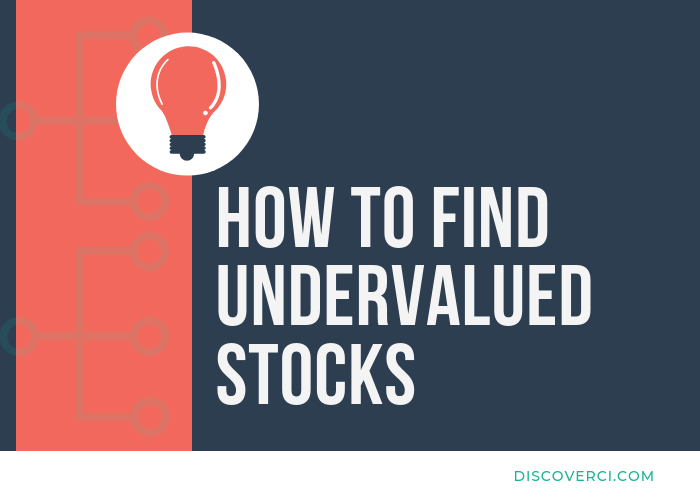Intrinsic value can be calculated using many different methods.
Unfortunately, the valuation models are complex and time consuming to complete.
In fact:
We built the DiscoverCI Stock Valuation Software to make valuing stocks quicker and easier.
We also developed an intrinsic value calculator to make it even more simple:
In the post below, we'll discuss the calculator's valuation model and walk through the step-by-step process for using the intrinsic value calculator.
Let’s dive right in.
Intrinsic Value Calcluation, Formula and Example
Intrinsic value is often calculated using a discounted cash flow (DCF) model.
We discuss how to use a DCF model in more detail here, and you can download our free stock valuation excel template here.
But today we are focusing on a different method for calculating a stock’s intrinsic value.
The Benjamin Graham Formula:

The Graham formula for calculating a stock is a simple method with relatively few inputs.
About the Benjamin Graham Stock Valuation Formula
Ben Graham is often called the “Father of Value Investing.”
He wrote several books on investing, including: Security Analysis with David Dodd, and The Intelligent Investor.
These books outline his theory, strategy and methods for long term success in the stock market.
There are many successful investors who have modeled their own investing strategies after Ben Graham, including Warren Buffett.
Graham focused on fully understanding a company before investing by analyzing a stock’s fundamentals.
He drew a clear distinction between investing and speculating, which he identified as the key to being successful in the stock market.

Graham indicated that you should invest in companies that are available on the market at a price below their intrinsic value.
To help identify stocks meeting this description, Graham proposed a formula to calculate a company’s intrinsic value.
Let’s walk through the calculation step-by-step.
Graham Formula: Step-by-Step Guide

A stock’s intrinsic value is generally defined as the value of the future cash flows of a company, discounted back to present value.
The Graham Formula for calculating the intrinsic value of a company is different.
You really only need three inputs to complete the calculation:
- The company’s trailing twelve month earnings per share,
- The expected growth rate of the company over the next 7 to 10 years, and
- The current risk free rate (Graham proposed using the current yield on AAA corporate bonds).
We’ve provided default values for the other formula inputs in the intrinsic calculator above.
You can change these inputs as well, but they generally stay consistent.
Step #1: Find the Trailing Twelve Month (TTM) Earnings Per Share (EPS)
A company’s earnings per share is the amount of net income they produce, divided by their total shares outstanding:
Earnings Per Share = Net Income / Total Shares Outstanding
You want to use the most recent available information in your calculation, which is usually the trailing twelve months.
For example:
Amazon’s earnings per share over the last 12 months is $20.70, which you can find on their stock overview page:
+TTM+Earnings+Per+Share.PNG)
After finding the TTM EPS of the company, your next input is the growth rate.
Step #2: Estimate the Company’s Future Growth Rate
A company’s growth rate drives their current valuation.
In the Graham Formula, you can estimate the future growth rate by using a number of different methods.
You can find the growth rate on the DiscoverCI valuation page as an input into the intrinsic value form:
+Growth+Rate.PNG)
You can also find analyst expected growth rates at Yahoo! Finance.
The DiscoverCI growth rate incorporates both average historical growth rates, and expected analyst growth rates.
If you’re using a growth rate purely based on future expectations, it’s important to analyze how that compares to historical actual growth.
You can find annual growth rate trends here:
+Annual+Growth+Rate+Trends.PNG)
The last input you need to use in our intrinsic value calculator is the current AAA corporate bonds rate.
Step #3: Find the Current AAA Corporate Bond Rate
Finding the current AAA Corporate Bond Rate is fairly simple.
Bond yields are tracked by several different agencies.
The website for FRED Economic Data is a good place to start:

As of the date of this post (April 13th, 2019), the AAA Corporate Bond Rate is 3.77%.
We use this rate as the default input in the calculator above, but you should update that rate for the most recent available information.
Step #4: Calculating Intrinsic Value
Using the Graham Formula detailed above, and the inputs obtained in steps 1 through 3, you can now calculate a company’s intrinsic value.
Let’s use Amazon as an example:
- EPS = $20.70
- Growth Rate = 29.36%
- Yield = 3.77%
Intrinsic Value = ($20.70 x (8.5% + (2 x 29.36%)) x 4.4) / 3.77%
The Graham formula calculator above returns an intrinsic value of $1,623.98 per share.
Amazon’s current stock price is $1,843.06.
Updating the Intrinsic Value Calculator
The intrinsic value formula used in our calculator was defined by Graham many years ago.
A lot has changed since he developed this formula.
Some investors use slightly modified formulas, by adjusting the no-growth company P/E ratio to 7, rather than 8.5.
They also will not multiply the expected growth rate by two, but rather use the estimated growth rate without modification in the calculation.
Modifying these two inputs would result in a very different result:
Intrinsic Value = ($20.70 x (7% + 29.36%) x 4.4) / 3.77%
After changing the formula, the new calculated intrinsic value is $878.43.
What’s Next?
If you're calculating the intrinsic value of a U.S. publicly traded company, you can skip all of these steps and let our stock valuation software calculate intrinsic value for you:
Value Any Stock FREE!
Hours of stock valuation analysis in 10 seconds or less!
Or
Use one of our other stock analysis or stock research tools:
- Head over to our stock analysis page and search for a stock to start your analysis
- Quickly calculate financial metrics using our collection of financial calculators
- Use our fundamental stock screener to filter and screen for awesome companies
- Get industry benchmarks for your valuation models by analyzing the average EBITDA multiples by industry
- Ready for another blog post? Check out our deep dive into finding undervalued stocks to buy in 2019







